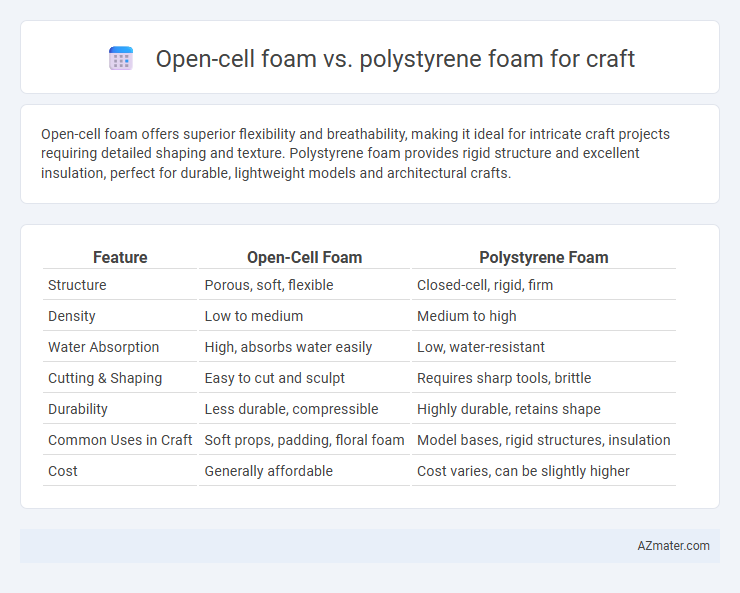Open-cell foam offers superior flexibility and breathability, making it ideal for intricate craft projects requiring detailed shaping and texture. Polystyrene foam provides rigid structure and excellent insulation, perfect for durable, lightweight models and architectural crafts.
Table of Comparison
| Feature | Open-Cell Foam | Polystyrene Foam |
|---|---|---|
| Structure | Porous, soft, flexible | Closed-cell, rigid, firm |
| Density | Low to medium | Medium to high |
| Water Absorption | High, absorbs water easily | Low, water-resistant |
| Cutting & Shaping | Easy to cut and sculpt | Requires sharp tools, brittle |
| Durability | Less durable, compressible | Highly durable, retains shape |
| Common Uses in Craft | Soft props, padding, floral foam | Model bases, rigid structures, insulation |
| Cost | Generally affordable | Cost varies, can be slightly higher |
Introduction to Open-Cell and Polystyrene Foams
Open-cell foam features interconnected cells that provide softness and breathability, making it ideal for craft projects requiring flexibility and cushioning. Polystyrene foam consists of closed, rigid cells that offer excellent insulation and structural support, favored for durable and lightweight craft applications. Understanding these basic cellular structures helps crafters select the appropriate foam type based on texture, strength, and project requirements.
Material Composition and Structure
Open-cell foam consists of interconnected air pockets, providing a soft, flexible texture ideal for cushioning and craft projects requiring pliability, while polystyrene foam features a closed-cell structure with rigid, compact beads offering superior insulation and structural support. The material composition of open-cell foam typically includes polyurethane, enabling breathability and moisture absorption, whereas polystyrene foam is made from expanded polystyrene beads that create a lightweight but sturdy framework. These differences in cellular structure and material chemistry directly impact their suitability for crafts, as open-cell foam is better for projects needing malleability, and polystyrene excels in durability and shape retention.
Weight and Density Comparison
Open-cell foam typically has a lower density ranging from 0.5 to 1.5 pounds per cubic foot, making it much lighter than polystyrene foam, which usually has a density between 1.0 and 3.0 pounds per cubic foot. This lower density in open-cell foam results in a softer, more flexible material ideal for detailed craft projects requiring lightweight components. Polystyrene foam's higher density offers more rigidity and structural support but adds more weight, which can affect the overall balance and handling in craft applications.
Workability and Cutting Ease
Open-cell foam offers superior workability for craft projects due to its flexible, porous structure, making it easy to shape, carve, and compress with hand tools or knives. Polystyrene foam, while rigid and denser, provides cleaner, more precise cuts using hot wire cutters or sharp blades but tends to produce more brittle edges and requires careful handling to avoid crumbling. Choosing between open-cell foam and polystyrene foam depends on the desired balance between ease of cutting, detail precision, and surface texture in crafting applications.
Surface Texture and Paint Compatibility
Open-cell foam exhibits a porous and flexible surface texture ideal for detailed crafting, allowing paint to absorb evenly without cracking. Polystyrene foam has a smooth, rigid surface that requires priming to ensure proper paint adhesion and prevent peeling. Both foams offer unique advantages, but open-cell foam's texture enhances paint compatibility and finish durability in craft projects.
Durability and Longevity in Crafts
Open-cell foam offers moderate durability with its flexible, porous structure that absorbs impacts but may degrade faster in high-friction craft applications. Polystyrene foam provides superior longevity and rigidity, resisting compression and moisture better, making it ideal for sculptures and models requiring long-term structural integrity. Choosing between these foams depends on the craft's exposure to stress and environmental factors, with polystyrene excelling in durability for lasting projects.
Cost Effectiveness for Projects
Open-cell foam offers superior cost-effectiveness for craft projects due to its lower material price and ease of shaping compared to polystyrene foam. Polystyrene foam, while stiffer and more durable, typically incurs higher costs and requires specialized tools for cutting and detailing, increasing overall project expenses. Choosing open-cell foam maximizes budget efficiency, especially for intricate, lightweight craft designs.
Environmental Impact and Recycling
Open-cell foam, often made from polyurethane, is less dense and more biodegradable than polystyrene foam, which is a petroleum-based product known for its persistence in landfills and marine environments. Polystyrene foam's recycling rates remain low due to contamination and collection challenges, whereas some open-cell foams can be more readily processed in specialized recycling facilities. Choosing open-cell foam for crafts reduces long-term environmental impact by enhancing biodegradability and supporting more sustainable waste management practices.
Ideal Craft Applications for Each Foam
Open-cell foam is ideal for craft projects requiring flexibility and cushioning, such as custom stamps, floral arrangements, and soft sculptures due to its porous structure and compressibility. Polystyrene foam excels in model making, architectural mockups, and laser-cut crafts, offering rigid support and smooth surfaces for painting or carving. Each foam type enhances specific creative needs: open-cell for pliable, tactile designs and polystyrene for structured, precise forms.
Choosing the Right Foam for Your Craft Needs
Open-cell foam offers exceptional flexibility and breathability, making it ideal for projects requiring cushioning and sound absorption, while polystyrene foam provides rigid structure and excellent insulation properties, perfect for detailed shaping and lightweight models. When choosing the right foam for your craft needs, consider factors such as durability, ease of cutting, and the desired finish, as open-cell foam is softer and more porous compared to the firm, smooth surface of polystyrene. Evaluating project specifics like longevity, paint compatibility, and environmental exposure ensures optimal material selection for successful craft outcomes.

Infographic: Open-cell foam vs Polystyrene foam for Craft
 azmater.com
azmater.com